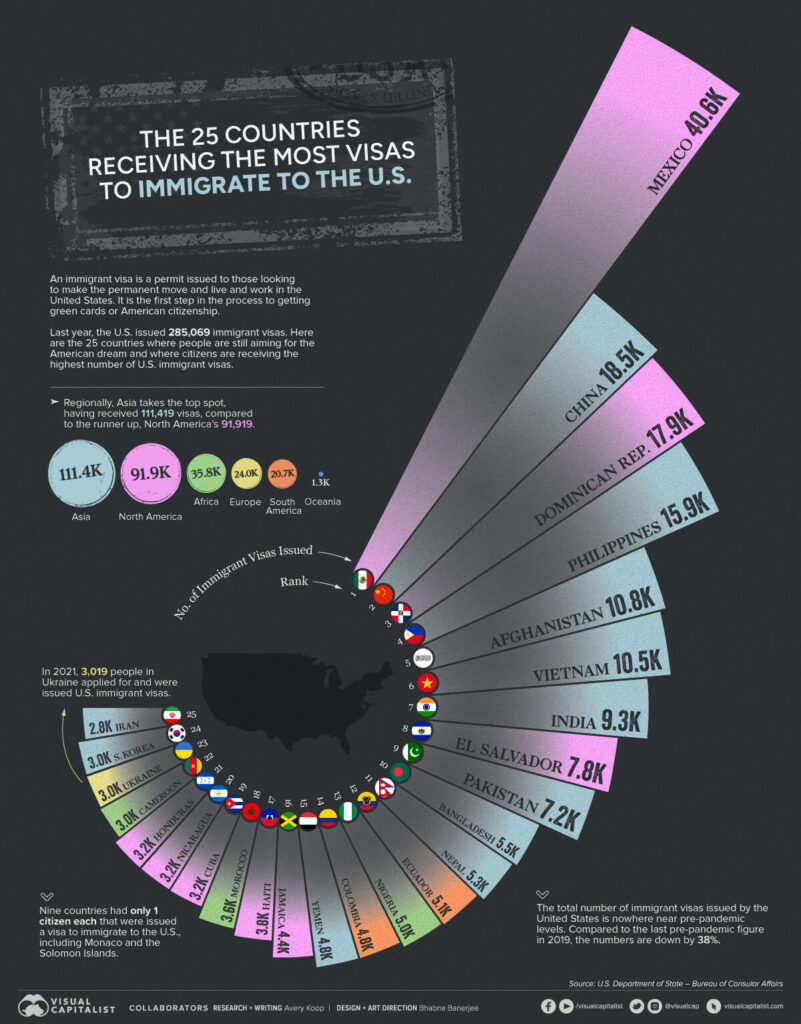This is our general resource for pharmacists looking to migrate to the US. If you are coming from a specific country you may want to use our country selector on the front page to get specific advice tailored to your country of origin and destination.
In order to work as a pharmacist in the United States, you must be a citizen or have a valid work visa. If you are not a citizen, you will need to go through the process of obtaining a work visa in order to work as a pharmacist in the United States. Here is a quick look at where most successful US VISA applications come from:

From the image above you will find that there is a slight bias in their selection, i.e. if you are geographically closer say from Mexico or the Dominican Republic you are more likely to get a VISA. However, what is not illustrated is the amount of VISA applications from each destination, for instance, India is 7th on this list however there may have been 100,000 applications relative to Mexico. Whatever the odds, the image shows it is possible and that the US is granting VISAs. Those that are more likely to go through are those who have prepared adequately.
We monitor all of the applicants which use our consultancy and know what works. As such we have formulated the advice below:
Steps for a pharmacist to become a US pharmacist…
- Recognition of equivalence – apply to Education Credential Evaluators (ECE) to look over your foreign qualification (you can send your Pharmacy Degree transcripts direct from wherever you live). Once they give you the green light you can then go and sit the equivalency exams. The main documents they ask for are:
- official university transcript
- proof of degree
- proof of A-Levels (or equivalent). The difference between the US and UK pharmacy programmes is a six-year (doctoral) degree, versus the UK’s five-year (master’s) degree. A-Levels (or equivalent) are considered similar to some US foundation-year undergraduate courses.
- Remember: Every application is considered on an individual basis and, as well as proof of my A-level results, I also submitted evidence of my postgraduate diploma as further support. It is worth checking with the National Association of Boards of Pharmacy (NABP) in advance to see what it recommends (NB: the only way to communicate with it is in writing or by fax).
- Obtain a work visa – if you have a spouse in the US you can skip this section! Granted by the UK section of the US embassy, in most cases, a job offer from a U.S.-based employer (see: list of US pharmacy employers) is required in order to qualify for a visa, so your first step here would be to find a pharmacy that is willing to employ you in the US. Within this visa application period, you should pass the following exams…
- Take the TOEFL Exam – this is an English proficiency exam that you will need to take to prove that you are competent in speaking technical English.
- Take the FPGEE Exam – Apply to the National Association of Boards of Pharmacy (NABP) to start the Foreign Pharmacy Graduates Equivalency Committee certification process.
- Start your Internship – register as a pharmacy intern with the state board of pharmacy and start recording hours. You will then need to submit records of internship hours to the state board of pharmacy/PCS once completed. The length of internships depends on which state you would like to migrate to. For instance in Maryland the internship time requirement is a flat 1500 hours, whereas in Washington state the hours titrate up dependent on your FPGEE Score i.e. if you score 75-90, you will need to have at least 1200 hours earned prior to the NPLEX/MPJE examinations, whereas if you score between 91-105 1000 – you will only need at least 800 hours. For a full list of the internship time requirement for different states please click the link. In addition, some students who find it difficult to secure a pharmacist internship will often work part-time as a technician to get their skill levels up.
- Take the NAPLEX Exam – once your internship is approved, you will need to take this national clinical competency exam which will cover you for all states.
- Take the MPJ Exam – 49 states require you to take the Multi-State Jurisprudence exam however some, more popular destinations, such as California require you to take a state-specific exam such as the CPJ Exam. Each pharmacist which takes the exam gets 5 attempts.
- Obtain professional liability insurance – one of the most commonly used is the HPSO which has links to the American Pharmacist Association (APhA).
- Add your suffix – “RPh”, which stands for “registered pharmacist”, can be used by anyone who has completed the licensure requirements and is currently registered to practice.
|
Online Discussion Groups to Join:
FPGE Exam of Facebook – an online group of students sharing questions about the FPGE exam.


